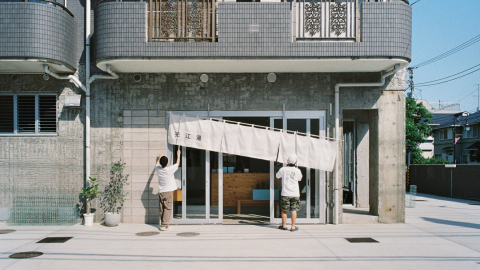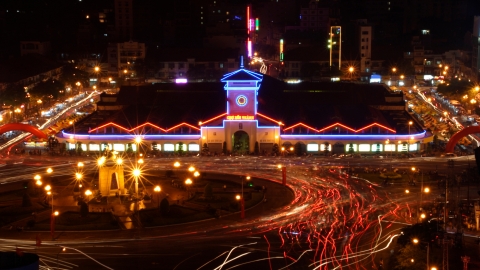On September 20, on the occasion of European Heritage Day, the French Consulate General's Palace in Ho Chi Minh City (6 Le Duan) opened its doors to the public. This annual event not only offers the opportunity to admire the more than 150-year-old architectural work but also helps visitors understand more about the historical and cultural imprints of France right in the heart of Saigon. According to the French Consulate General, this year's program is expected to attract about 1,500 visitors, demonstrating the special appeal of this rare heritage to the public.

A corner of the French Consulate General's Residence with classical architecture and elegant color scheme
Not only an ancient architectural work, the French Consulate General's Residence is also a symbol of the French philosophy of life - where people blend into the space, enjoy the light and let time pass meaningfully. That space is like a "silence" of modern life, where we can feel the beauty of stillness - a beauty that does not lie in the past but exists in every moment of the present.


Indochina architecture over 150 years old
Located among ancient trees on Le Duan Street, the building has a strong French architectural style with red tiled roofs, pale yellow walls and high windows to let in light. Amidst the hustle and bustle of life, this space still retains its tranquility and elegance – the spirit of “living with heritage” that the French value.
The French mansion was built around the end of the 19th century, officially completed in 1872, at the same time as other iconic buildings of Saigon such as Norodom Palace (now Independence Palace) and Notre Dame Cathedral. Initially, this building was the residence of the colonial military governor, then the Commander-in-Chief of the French army in Cochinchina. Since 1975, the building has officially become the residence of the French Consul General in Ho Chi Minh City.


Geographically, the Palace is located on what was once called the "highland", the highest point of the city at that time, providing a bright, open atmosphere, very suitable for establishing a long-term base. The functional spatial planning in this area from that period contributed to shaping the urban structure of Saigon. The design of the building is a typical example of late 19th-century French colonial architecture, with a classic European style but still in harmony with the tropical landscape of Vietnam. The internal layout reflects a unique combination of the majesty symbolizing power and the comfort of a private home.
Technically, this project shows uniqueness in construction: the walls are built with sand mixed with molasses, the structural frame uses steel and metal, and the tiles are imported directly from France. These special construction details have contributed to the architectural value and historical depth of the Palace.

Although the mansion is two stories high, this opening is limited to the first floor area for visitors, while the basement and upper floors are not open. The center of the mansion is the stateroom, where important diplomatic events are often held. This space stands out with the cultural exchange between East and West, with the highlight being the lacquer painting "Spring Garden" by famous artist Nguyen Gia Tri, created in 1939, hung solemnly on the wall. In addition, the stateroom also displays a separate eight-panel lacquer screen, along with many artifacts transferred from Norodom Palace and the former French consulate in Da Nang.
Nowadays, the concept of living heritage is becoming more and more popular in modern life. Instead of just preserving, people learn to live in communion with heritage, to see that the past is still present in every detail.
Photographer Phan Thanh Dat, who took the photos of the mansion, shared: "What impressed me most were the colors and light inside the mansion. The cool, gentle colors create a sense of luxury and elegance, while the windows along the corridor provide enough light and create interwoven contrasts." According to him, every small corner of the building tells its own story - where light, materials and architectural details create a slow but vibrant pace of life.

The interior space of the Palace is filled with natural light, preserving the elegance and sophistication of ancient architecture.


Heritage as a lifestyle – Tranquility amidst modern life
Inside the Palace, many valuable historical artifacts are preserved almost intact, from furniture in the style of the Nguyen Dynasty in Hue to antiques brought over by the French from the previous century. Even the cutlery cabinet in the hallway is still engraved with abbreviations reflecting each stage of production such as N (Napoleon III), GG (Governor General), RF (French Republic). An interesting architectural detail is the unique spiral staircase, said to be made from a French warship with a special structure that allows it to be disassembled and easily moved when necessary. The large dining area, where the Consul General often entertains guests, is also preserved intact.
The beauty of the Mansion lies not in its ostentation, but in the balance and sophistication of every detail: the mosaic-tiled corridors, the copper spiral staircase, the sun-filled window frames. All reflect the spirit of art de vivre – the French art of living, where natural light, materials and layout harmonize to create an elegant rhythm of life.

The French Consulate General's residence opens to visitors one day a year, attracting many young people to visit and capture moments in the ancient, elegant space.

The corridor is paved with exquisite mosaic tiles, a distinctive highlight that evokes a sense of nostalgia and elegance in the mansion space.




The interior space is delicately decorated with decorative items bearing strong European influences.


Photographer Thanh Dat added: "When taking this photo series, I wanted to capture and convey the beauty of European architecture in the rare remaining buildings in Saigon. It has a classic, European style, interwoven with a bit of inspiration from the Indochina region with decorations that are distinctly Vietnamese and Asian... All create a unique, impressive and harmonious feature. It can be said that the interior and architecture of the French Villa are unique in their own way that cannot be found in any other classic building in Saigon."


The Buddha statue in the corner of the yard creates a tranquil highlight, evoking a sense of peace in the ancient space.
The French Consulate General expressed its deep appreciation for the public's interest in this event. On its official Facebook page, the Consulate General shared: “This shows your interest and enthusiasm for this historic project. We would like to express our sincere thanks to all of you for contributing to this success!” The opening of the French Palace is not only an opportunity to admire a heritage architectural work but also helps visitors learn more about the diplomatic history and cultural imprint of France in Ho Chi Minh City, making this a rare cultural experience.
Amidst the hustle and bustle of Saigon, the mansion becomes a quiet space, reminding us that travel is not just about going far, but also about returning – returning to spaces that evoke identity, where people find balance and spiritual depth. An ancient mansion, a small house in the middle of the forest or a quiet cafe under the shade of trees – all can become destinations if we know how to listen to the breath of space.

 EN
EN





























